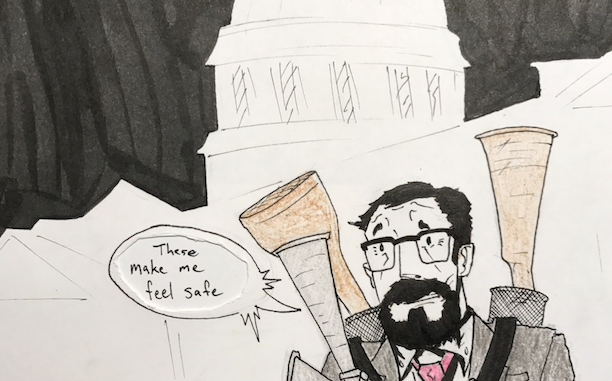
Mass shootings have sadly become a part of the American fabric, and though they never become any less upsetting, they have, for many, become less and less shocking. Still, it can be difficult not to feel like the world is ending in the wake of the kind of massacre that occurred in Las Vegas, Nevada earlier this week. On Oct. 1, 64-year-old Stephen Paddock, from the 32nd floor of the Mandalay Bay Resort and Casino, opened fire on attendees of an outdoor country music festival on the Las Vegas Strip. Over 60 people were killed and over 500 injured, making this event the deadliest mass shooting by a lone individual in United States history.
When police raided Paddock’s hotel room, they found 23 rifles and one handgun; a search of Paddock’s home revealed another 19 firearms. In addition to the 24 firearms discovered in the hotel room, police also found two “bump fire stocks,” modifications that harness recoil energy to increase a gun’s rate of fire, effectively transforming a semi-automatic rifle into an automatic one. Police have since confirmed that these stocks were, in fact, used by Paddock to emulate automatic fire. Bump fire stocks are currently legal to purchase in the United States, as they have “no automatically functioning mechanical parts or springs,” according to the Firearms Technology Branch of the Bureau of Alcohol, Tobacco, Firearms and Explosives.
Nevada’s gun laws are even less restrictive and sometimes outright nonexistent. Currently, there are no state laws on the books that would require someone to obtain a license prior to purchasing a firearm and once a firearm is purchased, there is zero legal obligation to register it. Nevada also has no limit on the number of firearms someone may purchase at one time. Background checks are conducted by the Nevada Department of Public Safety, but only at the request of a private seller; otherwise, only federal regulations of private firearm purchases apply. Additionally, Nevada has no mandatory waiting period for purchasing a gun.
We at The New Paltz Oracle believe that sensible gun control legislation is long overdue. According to the non-profit Gun Violence Archive, 273 mass shootings have occurred so far in 2017; as of the date of this editorial’s publication, 278 days have passed since the beginning of the year, averaging out to nearly one mass shooting every day. The crowd-sourced database massshootingtracker.org reports an even higher number of mass shootings in 2017, 340 thus far, with a total of 472 people killed and 1,757 injured (differences in mass shooting totals can be attributed to differences in data collection methods). Additionally, mass shootings appear to be a uniquely American problem; according to FiveThirtyEight, 90 mass shootings occurred in the U.S. between 1966 and 2012, while “the next four countries with the most mass shootings had 54 combined” in the same time span.
Even worse, the frequency and deadliness of mass shootings don’t even begin to illustrate the scale of the problem of gun violence in the United States. A report from the Brady Center to Prevent Gun Violence shows that approximately 67 percent of gun deaths in the United States are not even homicides, but rather suicides. The roughly 12,000 gun homicides that occur each year comprise the remaining third of gun deaths. These statistics are, unfortunately, also unique to our great nation, as a 2016 study by The American Journal of Medicine found that the gun homicide rate in the United States is 25 times higher and the gun suicide rate eight times higher than those of the 22 other high-income nations included in the study.
The vastly higher rates of gun violence in the United States can be explained by the country’s firearm-obsessed culture, with a 2012 report by the Congressional Research Service finding that, in 2009, there were roughly 310 million firearms owned by U.S. civilians—a number greater than the entire U.S. population at the time. But the massive quantity of firearms owned by civilians doesn’t solely impact the rate of deaths exclusively by guns. A 2009 study published in the peer-reviewed journal Applied Economics Letters came to the conclusion that rates of gun ownership “have a statistically significant and positive effect” on homicide rates, and that “efforts to restrict access to firearms would reduce murders.” Additionally, the American Journal of Public Health published a study earlier this year that indicated a decrease in suicides from 2013 to 2014 in states that instituted universal background checks and mandatory waiting periods.
We at The New Paltz Oracle understand the importance of the Second Amendment, particularly in areas with long emergency response times. However, we also believe that common sense legislation will make the United States a safer place without impeding on the individual right to carry a firearm. In 2012, Adam Lanza massacred 20 children and six adults at Sandy Hook Elementary School, and Congress did nothing. In 2015, Syed Rizwan Farook and Tashfeen Malik murdered 14 people at the Inland Regional Center in San Bernadino, California, and still Congress did nothing. In 2016, Omar Mateen slaughtered 49 people at the Pulse nightclub in Orlando, Florida, and, once more, Congress did nothing. Time and time again, this nation has wasted its time with “thoughts and prayers” instead of taking action to address the underlying issue. Now, following the gun deaths of over 60 more innocent civilians in Las Vegas, we implore our representatives and fellow American citizens to avoid falling into the trap of passivity yet again, lest our already-austere statistics continue to worsen.
